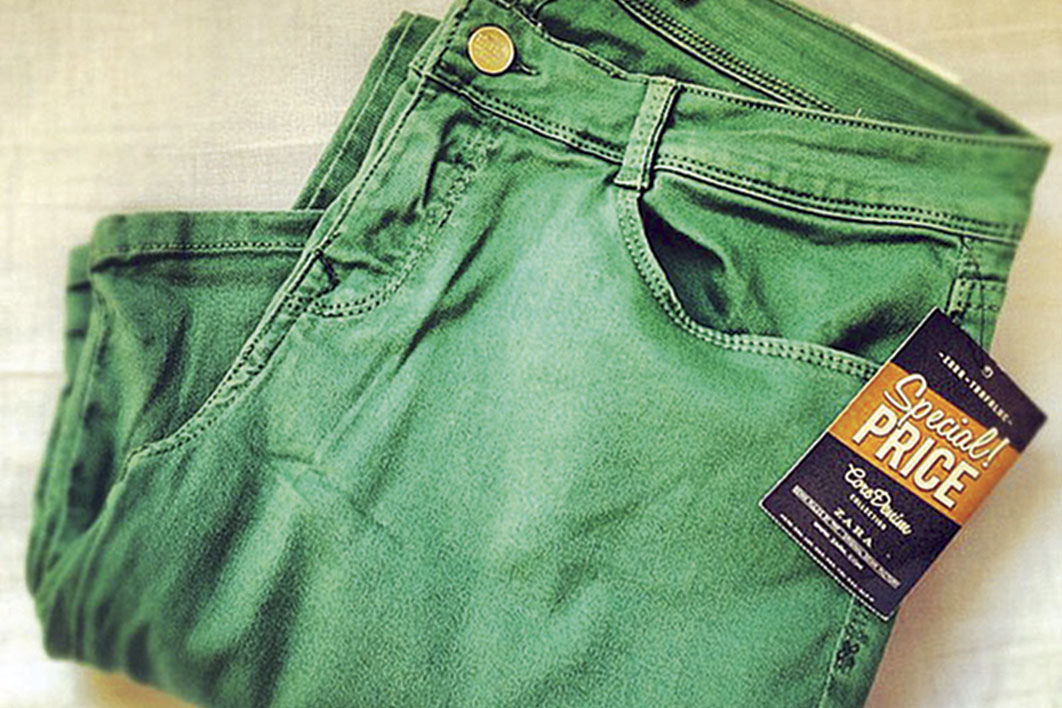Overdressed: The Shockingly High Cost of Cheap Fashion
By Elizabeth L. Cline | Portfolio | $29.95
The prices on just one page of the unapologetically titled magazine Shop Til You Drop range from $30 to $3000. Catering for everyone from the cheapskate to the high-end fashion fantasist, the magazine touts everything from “a high-street trend bomb! Team your blush tones with the metallic accents of this fab tote” (translation: a beige plastic handbag from chain store Forever New, rrp $69.99) to “a house classic, this Cape Cod watch in nautical-inspired cobalt has us reaching for our purses” (a Hermes watch, rrp $2940).
The glossy spread is a perfect illustration of Elizabeth Cline’s case in Overdressed – that high- and low-end fashion are working in tandem, and at great speed, to create a global epidemic of wardrobe lust and dangerous levels of overconsumption.
Overdressed is a cringe-inducing read for anyone who’s ever boasted that their new shirt only set them back twenty bucks. Cline was one such bargain bragger, but her three-year investigation into the fashion industry shows how the bid for a cheap buy “has all but wiped out the American garment industry” and “made it very difficult for small designers and independent companies to find proper and affordable factory resources… and charge prices that generate fair profits and pay decent wages.”
But Cline’s study is not just about how unrealistic our notion of a fair price is. It’s her insight into manufacturing-on-speed that makes this book especially compelling. Here in Australia, the fast-fashion phenomenon – “a radical method of retailing that has broken away from seasonal selling and puts out new inventory constantly throughout the year” – is relatively new. Spanish megastore Zara, the industry leader in the field, opened its first store in Sydney in April 2012; Britain’s Top Shop had opened in Melbourne a few months earlier. Both stores had people queuing overnight for the chance to elbow their way through the double doors.
Gone is the quaint notion that one line of clothing will herald the autumn or spring season or that an omniscient Vogue editor has the power to dictate the season’s look. As Cline documents, Zara delivers new lines twice a week to its stores, Top Shop introduces 400 new styles a week on its website, and Europe’s H&M and the US chain Forever 21 receive shipments of new stock every day. Zara customers now buy from the store an average of seventeen times a year.
This continuous consumption results in a kind of wardrobe gluttony – buy, purge, buy, repeat. But Cline’s account of the phenomenon is a confessional rather than a lecture, so she starts the journey at her own wardrobe door. “Americans buy an average of sixty-four items of clothing a year, a little more than one piece of clothing per week,” she writes. “It might not seem all that extreme, until you see it all piled up in your living room… My three hundred–plus-piece clothing collection made me almost exactly an average American consumer.”
Overdressed asks questions of the generation who no longer knows how to sew a button and finds it cheaper to buy a new pair of shoes rather than visiting the cobbler. In Cline’s estimation, we’re not savvy consumers, we’re suckers: “Most of the time we are buying the same basic item of clothing… over and over again, just tweaked slightly with the season’s must-have feature.”
The “democratisation of fashion” has come hand in hand with the worship of the designer brand – a heady cocktail of Sex in the City–endorsed shoe worship, celebrity infatuation and “You’re worth it” self-obsession. Whether they’re rich or distinctly middle-class, consumers in the developed world are bound by the same sickness and the same “tyranny of trends.”
Cline takes a stab at what drives the “manufactured yearnings” that grace the pages of glossy mags like Shop Til You Drop. She ventures that it’s not just the ever-changing window displays of these superstores, it’s also “the internet age and the dissemination of information through blogs, social networking sites, and tabloids… pushing fashion forward at greater speeds.”
Meanwhile, cheap fashion prices are not pulling down designer price tags but driving them up. Consumers are “using clothes as a type of competitive consumption,” shopping at the high end specifically to “max out their Visas.” Welcome to the “Veblen goods” principle – the economists’ observation that high prices become attractive because they suggest wealth and status. Clothing, as personal expression, is the very embodiment of this effect.
Clines flits between appealing to the readers’ social conscience and to their sense of style, devoting a chunk of the book to the detrimental effect that fast fashion is having on our much-lusted-over threads. Quality, and long-lasting quality at that, “has been whittled away little by little, to the point where the average store-bought style is an extraordinarily thin and simple… facsimile of a garment.” And our clothing supply “can only get shoddier from here.”
After peering into the sewing kit and the sock drawer, Cline widens the lens to examine the impact of that Made in China tag – which is sewn into the back of a staggering 41 per cent of America’s clothes – on local manufacturing. She documents the rapid rate at which big brands moved their manufacturing offshore as import barriers in the United States were wiped out in the mid nineties.
She chronicles the fallout from aggressive trade liberalisation via the North American Free Trade Agreement and the decade-long phasing-out of the longstanding Multi Fibre Arrangement quota system. Changes like these saw brands like Nike and Gap become a new kind of clothing company that “only designed and marketed clothes rather than making them.”
The United States now makes just 2 per cent of the clothing its consumers purchase, down from about 50 per cent in 1990. In 1996 the American textile industry employed 624,000 workers; today, that number is 120,000. Levi’s, that embodiment of American power decked out in blue denim, was one of the last major garment manufacturers to give in and source from overseas, closing its last factory in San Antonio, Texas, in 2004.
The effects of these changes, not just on local manufacturing but also on work practices around the world, were well-documented in the late 1990s in books like Naomi Klein’s No Logo. Consumer awareness has come full circle since that black-and-red bible of the anti-sweatshop protest movement first graced bookshelves.
For a brief moment the concept of purchasing power seemed to take root in the public consciousness, and a fairly sizeable protest movement was beginning to raise public awareness about the downside to that relatively new buzzword, globalisation. Some gains were made – codes of conduct, “social responsibility” and compliance audits are now regular practice in many factories, or at least the buzzwords are regularly employed. But fast fashion’s speed and corner-cutting is compromising this progress.
The logistics of feeding this new global habit is one of the more fascinating aspects of Cline’s investigation. “Zara’s retail employees carry customised handheld computers to feed information about what’s selling, customer reactions, and buzz about new styles,” reports Cline. “They’ll make last minute calls to their factories, where more than 50 per cent of the fabric is waiting undyed so they can change the colour mid season if need be.”
The sheer size of global fashion behemoths like Zara means their seemingly impossible demands are met, and often they are met in China. Cline takes a personal tour of several factories in Guangdong Province by posing as her own fashion outlet, Fashion Forward Inc., and then identifying potential suppliers for her fictional fashion label on Alibaba.com, the world’s largest business-to-business website, which throws up “more than one million results when you search for women’s wear on mainland China.”
The sheer numbers behind China’s garment industry – “several times bigger than any garment industry that’s happened anywhere in the world at any point in history,” according to Cline – are difficult to digest. China boasts more than 40,000 clothing manufacturers and fifteen million garment industry jobs. Compare that to the 1.45 million jobs at the peak of the garment and textile industry in the United States some forty years ago. Those huge numbers help explain how the Chinese industry has been able to specialise to a degree that is “beyond belief.” One coastal city near Shanghai, for instance, produces most of the world’s socks: nine billion pairs a year.
Cline has a stab at chronicling the environmental costs of our habit, although not to the extent of Lucy Siegle’s 2011 book To Die For: Is Fashion Wearing Out the World?. “A tremendous amount of clothing is in fact not getting recycled but getting trashed,” she writes, “and the environmental impact of making clothes is being entirely overlooked.” Cotton production has its own environmental costs, as does the production of synthetic fibres, which has almost doubled over the past fifteen years. In Asia, which has poured enormous investment intoits manufacture, production of polyester now exceeds twenty-two billion kilos a year, with China producing well over half that volume.
Then there’s the striking fact that the young Chinese workers at these factories are decked out in the fashions that are hammered out by their machines. This is an increasingly affluent society developing its own taste for the fast-fashion flavour. “As China and India develop consumer classes and gain a taste for fashion, the total quantities of fiber production are growing dramatically along with the burden on resources,” writes Cline. “Ponder this for a second: a population of 1.3 billion people consuming clothes with the furious intensity that Americans do.”
The flip side of China’s growth, of course, is that the cost of labour is soaring, putting American manufacturers in a panic. Having offshored a sizeable chunk of their manufacturing operations to this rising superpower, US labels are now in something of a bind: China is becoming too expensive. Cline follows the flight of cheap labour out of China and into Bangladesh, one of the lower-wage countries – others include Cambodia, Vietnam and India – benefiting from China’s rising costs.
The closest Cline comes to offering any kind of solution to the twin problem of the exploitation of foreign workers and the employment crisis in US manufacturing is to float the concept that consumers should demand that workers are paid a living wage. She visits the Alta Gracia factory in the Dominican Republic, where workers are unionised and paid a living wage, to demonstrate what a difference decent pay can make to the community. The factory is operated by South Carolina–based Knights Apparel, the leading producer of college-logo clothing sold at American universities, and the demand for such standards has mainly come from the students.
This is the point that Cline stresses – that the consumer can make a difference, whether by buying sustainable clothing, making their own clothes or, at the very least, curbing their spending habits. She examines the rise of slow, sustainable fashion by interviewing designers, tailors and sewers dedicated to creating long-lasting, high-quality, realistically priced clothes.
She also urges personal responsibility, suggesting that “we are all stewards of our own clothing.” Like the slow food movement, it’s about going back to basics: “building a wardrobe over time, saving up and investing in well-made pieces, obsessing over the perfect hem, luxuriating in fabrics, and patching up and altering our clothes are old-fashioned habits. But they’re also deeply satisfying antidotes to the empty uniformity of cheapness.”
The degree to which readers will engage with Cline’s journey relies heavily on how well they can relate to her distinctly first-world problems. At times, the book could also do with a dose of self-deprecation. After all, fashion is fun and funny, a distinctly guilty pleasure. Ultimately, Cline issues a kind of clarion call for consumers to wrestle back the notion not so much of fashion, but of personal style.
“Dressing sharp, dressing up, and caring about what we wear existed long before the fashion industry, and these values can exist outside it as well. Surely our clothing can be defined by something other than price-gouging designers, discounted brand names, or the cheap trends that follow them both.” •




